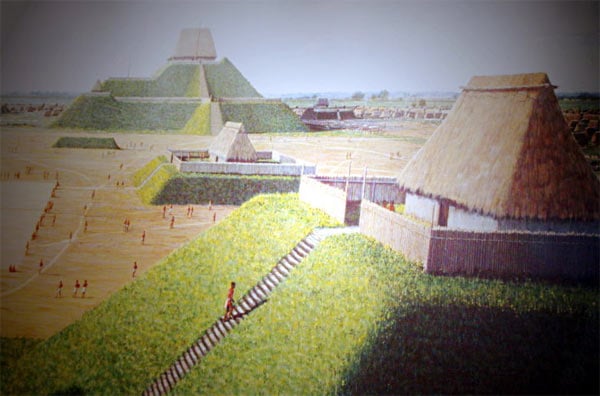What Caused Fire Which Destroyed America’s Most Prosperous Ancient City?
The ancient Native American city of Cahokia, which was built around 600 AD, was once home to 15,000 inhabitants, stretches of farmland, wealthy communities and surrounded by 120 pyramids similar to Mayan temples. However, in 1170 AD it was ravaged by a massive blaze which left the city in ruins, leading to dramatic changes in their society, culture and architecture. Now a new study has presented strange new evidence leading to exciting theories about the cause of the fire.
The secrets of the ancient city of Cahokia lie buried below where St Louis, Missouri stands today in an area which is considered the largest and most complex archaeological site north of the great Pre-Columbian cities in Mexico. Cahokia covered a vast area of about 6 square miles and is famous for its earthen mounds, which constitute the largest prehistoric earthen constructions in the Americas north of Mexico, and for evidence of ‘an American Woodhenge’, in which a series of postholes would have once held a timber circle that marked solstices and equinoxes.
The mounds were believed to have been built as a place of worship and seem to have had religious significance to the dwellers, with tombs below and places of ceremony on top. Like the Mayans, the civilization was also known to make human sacrifices, including dismembering and burying people alive.
However, one of the greatest mysteries surrounding this World Heritage listed site is the devastating fire which ripped through the main ceremonial plaza in the centre of the city, destroying many of the buildings which were wooden with thatched roofs. Surrounding this peculiar event is the fact that after the fire the city was a changed place: new architectural designs sprung up, along with new defensive walls. In the original city, the rich and powerful lived in large homes whereas following the blaze all the structures became more regulated and smaller. There was also a sudden influx of clay plates featuring sun symbolism. Was this a sign of a new spiritual or political regime in the area? What is clear is that the fire marked a major turning point in Cahokia’s civilization, and perhaps the beginning of an end; but why?
This was a question that a new scientific investigation published this month in the Journal of Field Archaeology attempted to find out. University of Illinois at Urbana-Champaign archaeologist Timothy R. Pauketat and his colleagues pored over new dig sites in East St. Louis, and examined the evidence for the fire, and what they found was extremely strange.
The 100 or so thatched buildings that had been destroyed were all packed with luxury items such as clay pots, pipes, and animal bones used in ceremonies, items which were not typically found in regular homes. No garbage pits or normal household items could be found. The houses also appeared to have been hastily constructed, indicating that they were more like temporary structures, and they were placed much more closely together than elsewhere in the city.
Another strange finding was that the homes which were burned were not rebuilt. Previous digs in Cahokia showed that if houses burnt down, the dwellers would rebuild on top however in this instance, the ashes were swept into piles and left untouched.
The researchers believe that all these clues point to the fact that instead of the fire being an accident or being set by an enemy, it was in fact a mass sacrifice. It wasn't uncommon for the mound builders to burn the structures they built at the top of mounds in ceremonial events. But if this fire was sacrificial, it was on a scale that was unprecedented.
One theory is that the fire marked a decline in the city’s power and the sacrifices were part of an on-going effort to bring back the city’s former status. If this was the case, it was not successful because by 1400, Cahokia and its environs had been almost entirely abandoned. It lost power and never regained its reputation again.



















